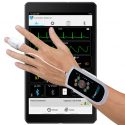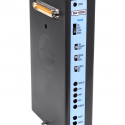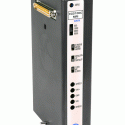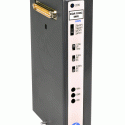CBLCAL is a device used to check the accuracy of BIOPAC biopotential amplifiers. CBLCAL stands for cable calibration and is used to calibrate EMG, EOG, EEG, ECG, and ERS amplifiers.…
Search
The TEL100 System is an earlier model of the BIOPAC Remote Monitoring System that is functionally equivalent to the TEL100C system described in this note; it uses different cables to…
Showing 4 of 363 products
An electrocardiogram (ECG) is a graphic recording of the changes occurring in the electrical potentials between different sites on the skin (leads) as a result of cardiac activity. Depolarization of…
Offset refers to the zero point or baseline of a signal. BIOPAC biopotential amplifiers (including the DA100) are preset at the factor to Offset 0. When recording in AC mode,…
This application note will measure nerve conduction velocity along the ulnar nerve of a human subject. This is a standard site for nerve conduction velocity measurement due to the relatively…
To record a continuous 12-lead ECG, use a WT100C Wilson Terminal to create a virtual reference electrode when measuring the transverse plane (i.e., precordial) ECG components [V1, V2, V3, V4,…
The TEL100C-RF remote monitoring system can monitor a wide range of physiological activity, including ECG, EOG, EEG, GSR, SKT, PPG, RSP, and surface EMG. Specialized signal processing of physiologic variables…
The BAT100 is a sealed lead-acid rechargeable battery pack and recharger designed to operate with the MP100 system. The battery pack comes in a handy carrying case equipped with a…
The O2100C Oxygen Measurement Module records quickly-varying oxygen concentration levels. The O2100C module is equipped with a variable speed pump to adjust the flow over a wide range of sampling…
The CO2100C Carbon Dioxide Measurement Module records quickly varying carbon dioxide concentration levels. The CO2100C module is equipped with a variable speed pump to adjust the flow over a wide…
The HLT100C module is used to interface all high-level output transducers to the MP System and provides 16 input and 2 output channels. The HLT100C is similar in function to…
A major factor affecting breath-by-breath respiratory gas measurements is the response time of the O2100C and CO2100C modules. Although the CO2100C module has somewhat faster response times than the O2100C…
MP System (MP160, MP150, MP100) stimulation features provide a powerful vehicle for outputting a variety of wave shapes of varying duration, coincident with the data acquisition process. This application note…
The LDF100C Laser Doppler Flow Module section covers the following topics: Features & Controls Operating Restrictions – Cautions and Warnings Installation and Operation User Maintenance Specifications General Overview of the…
MP150 and MP100 System stimulation features provide a powerful vehicle for outputting a variety of waveforms of varying duration, coincident with the data acquisition process. Often, a stimulation voltage in…
Signals from transducer catheters are suitable for high-fidelity pressure monitoring with high-frequency response data acquisition systems such as the MP Research System (using MP150 or MP100 unit), and are therefore…
BIOPAC Systems, Inc. has a solution to compatibility issues for communication between the iMac and G3 line of Apple Computers and the MP30 and MP100 units.
This application note explains how to record electrodermal activity (EDA/GSR) and observe electrodermal response (EDR) changes with the EDA100C Electrodermal Activity amplifier, GSR100C Galvanic Skin Response amplifier, or TEL100C telemetry…
The MCE100C micro-electrode amplifier module is useful for a wide range of physiological recording applications that require the use of micro-electrodes, such as cellular single channel analysis. Micro-electrodes, due to…
The MP100 and MP150 systems employ separate methods to acquire data in order to accommodate the differences in sampling speeds and aggregate rates between the two systems. Both systems are…
Cardiac Output can be determined, noninvasively, by employing electrical bio-impedance measurement techniques. Electrical bio-impedance is simply the characteristic impedance of a volume of tissue and fluid. In the case of…
To record a continuous 12-lead ECG, use a WT100C Wilson Terminal to create a virtual reference electrode when measuring the transverse plane (i.e., precordial) ECG components [V1, V2, V3, V4,…
This application note will explain how to update the MP unit firmware, install the AcqKnowledge software and make all necessary connections to acquire data when using one or more MP150s…
This application note will explain how to update the MP unit firmware, install the AcqKnowledge software and make all necessary connections to acquire data when using one or more MP150s…
This Application Note will explain how to update the MP unit firmware, install the AcqKnowledge software and make all necessary connections to acquire data when using one or more MP150s…
Cardiac Output can be noninvasively determined by employing electrical bioimpedance measurement techniques. Electrical bioimpedance is simply the characteristic impedance of a volume of tissue and fluid. In the case of…
The NIBP100A is a noninvasive blood pressure monitor that uses a pressure sensor placed on the wrist over the radial artery. This device uses a “sweep technique,” which applies a…
The NIBP100B is a noninvasive blood pressure monitor that uses a pressure sensor placed on the wrist over the radial artery. This device uses a “sweep technique” which applies a…
The NIBP100B-R is a noninvasive blood pressure monitor that uses a pressure sensor placed on the wrist over the radial artery. This device uses a “sweep technique” which applies a…
This application note is concerned with the recording of real-time physiological data, from a human subject, during fMRI, using BIOPAC’s series of MRI Smart Amplifiers: ECG Electrocardiogram Amplifier for MRI…
This application note lays out some generally recommended methods for recording data from subjects in the MRI or fMRI. BIOPAC Systems, Inc. (BIOPAC) designs systems that can be used to…
ECG waveforms can be “scrubbed” of MRI artifact with the judicious application of hardware and software tools. However, even with specialized hardware filtering (as with the MRI-specific amplifiers), some residual…
A wide range of meaningful information can be extracted from tri-axial acceleration measurements. This application note considers an example case of measurements associated with a subject who is using a…
A significant methodological concern in impedance cardiography is related to the impact of movement artifacts on recorded data. Ensemble averaging methods provide a strategy to remove these artifacts. Wearable and…
This application note examines a conventional equipment setup for metabolic measurements. The setup is exposed to a propane-based, combustion verification source that emulates subject’s steady-state consumption of oxygen and production…
Tilt angle or inclination sensing uses measurements of gravity, and its trigonometric projection on the axes of a tri-axial accelerometer, to determine tilt angle in all three spatial dimensions (X,…
This Application Note describes how to record percent End-Tidal CO2 (% ETCO2) using a BIOPAC CO2100C Carbon Dioxide Amplifier. The note details subject interface options for high flow without a…
This application note addresses EDA and ECG measurements performed in a Siemens 7T fMRI. BIOPAC MRI Smart Amplifiers were used to record ECG LEADII and EDA from the fingertips. Standard…
This application note is concerned with the nature of ECG100C and ECG100C-MRI timing delays. In particular, the focus is on ECG data collected in fMRI or MRI for the express…
This Application Note demonstrates how to sample and display calculation channel data through external devices such as LED’s or 7-segment displays via UIM100C digital output ports. In this exercise, BPM…
Blood Flow Measurements using the NICO100D This application note discusses Trans-Radial-Ulnar Electrical bioimpedance Velocimetry (TRUEV); measurements and analysis; the configuration discussed interrogates both the radial and ulnar (TREV >> TRUEV)…
This application note presents a way to monitor the convergence of gas concentration values in a GASSYS3. The response curve is simulated using an RC filter with a long time…
BIOPAC lets you measure physiology anywhere with innovative, compatible solutions that can be used by anyone for meaningful discovery. We make high-quality scientific tools for physiology measurement and interpretation with…
AC mode indicates that a high-pass (HP) filter has been applied to the signal that you are recording. An HP filter removes the low-frequency components of a signal. The most common…
Take experimental investigations of emotion and attention to the next level! Affective Immersive Emotional Virtual Reality Stimuli Systems for Neuroscience ResearchComplete Researcher Control, Ready-to-Run Scenarios, Fully Customizable New! aLIAS packages…
The UIM100C is bidirectional. With a BIOPAC amplifier connected to the UIM100C, the appropriate input becomes an output. For example, if you have an ECG100C module set to channel 1,…
If the signal from the amplifier is not on zero, it is possible to remove the offset by using the Zero Adj screw at the top of the amplifier. Make…
Use the CBL201 to convert older amplifiers that use 2 mm pin sockets to the newer 1.5 mm touchproof connectors. This is useful if you have an older amplifier with…
All BIOPAC amplifiers have multiple low pass and high pass filter settings. When setting the switches on the amplifier, the following rules apply: The lowest Low Pass filter value will be applied…
Use BIOPAC amplifiers with MP Systems, as stand-alone devices, or with 3rd-party flow meters, force plates, sono-micrometers, telemetry equipment, metabolic carts, etc.




Stay Connected